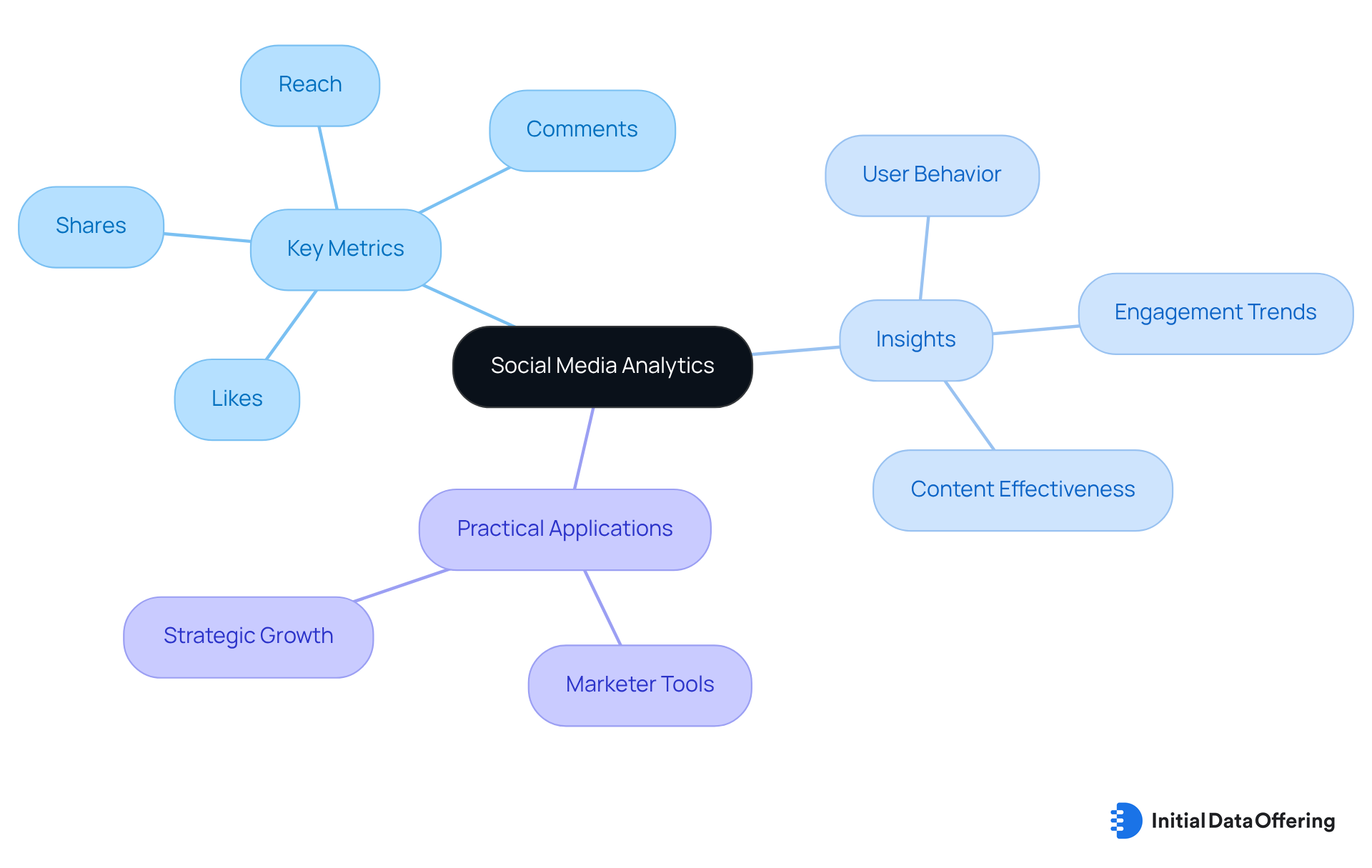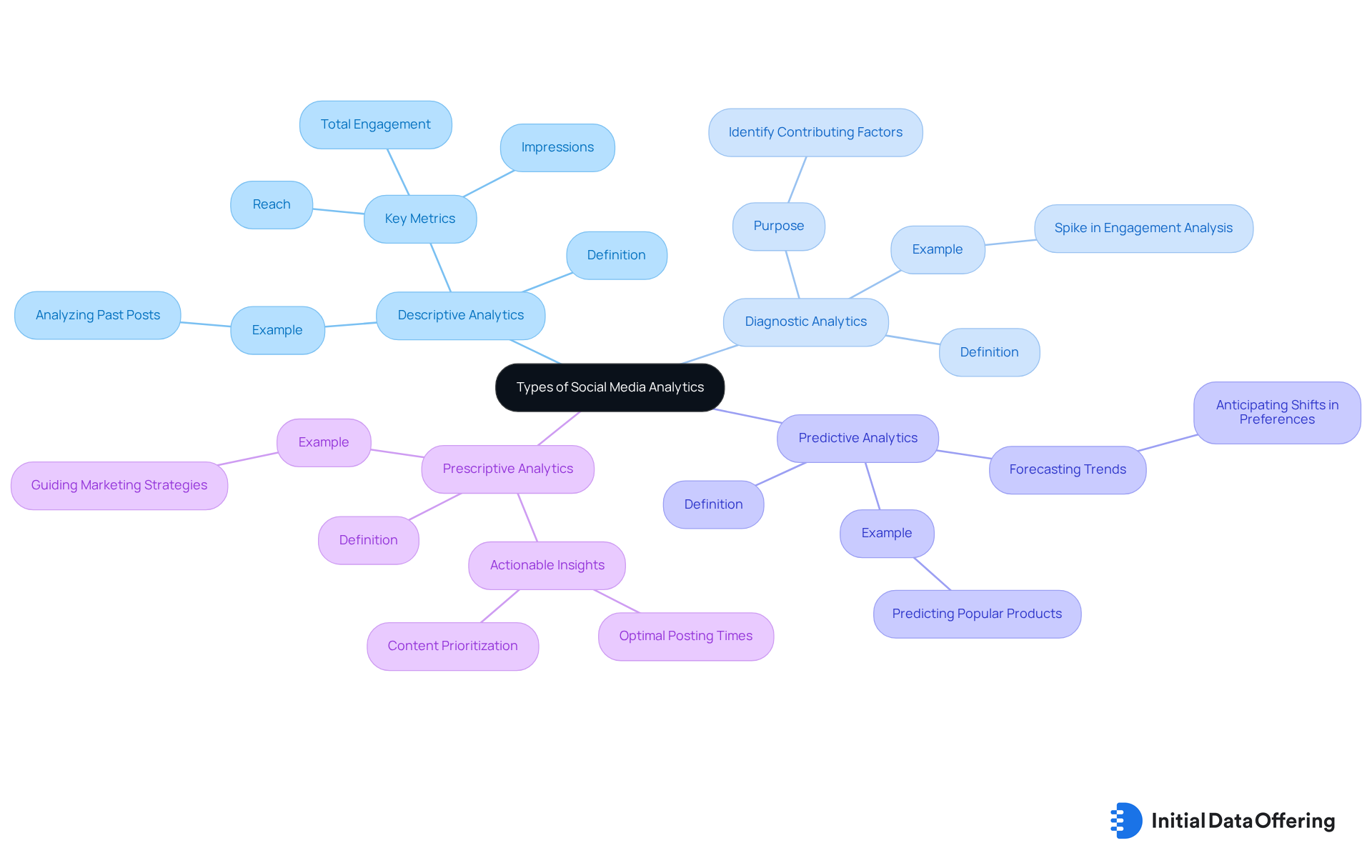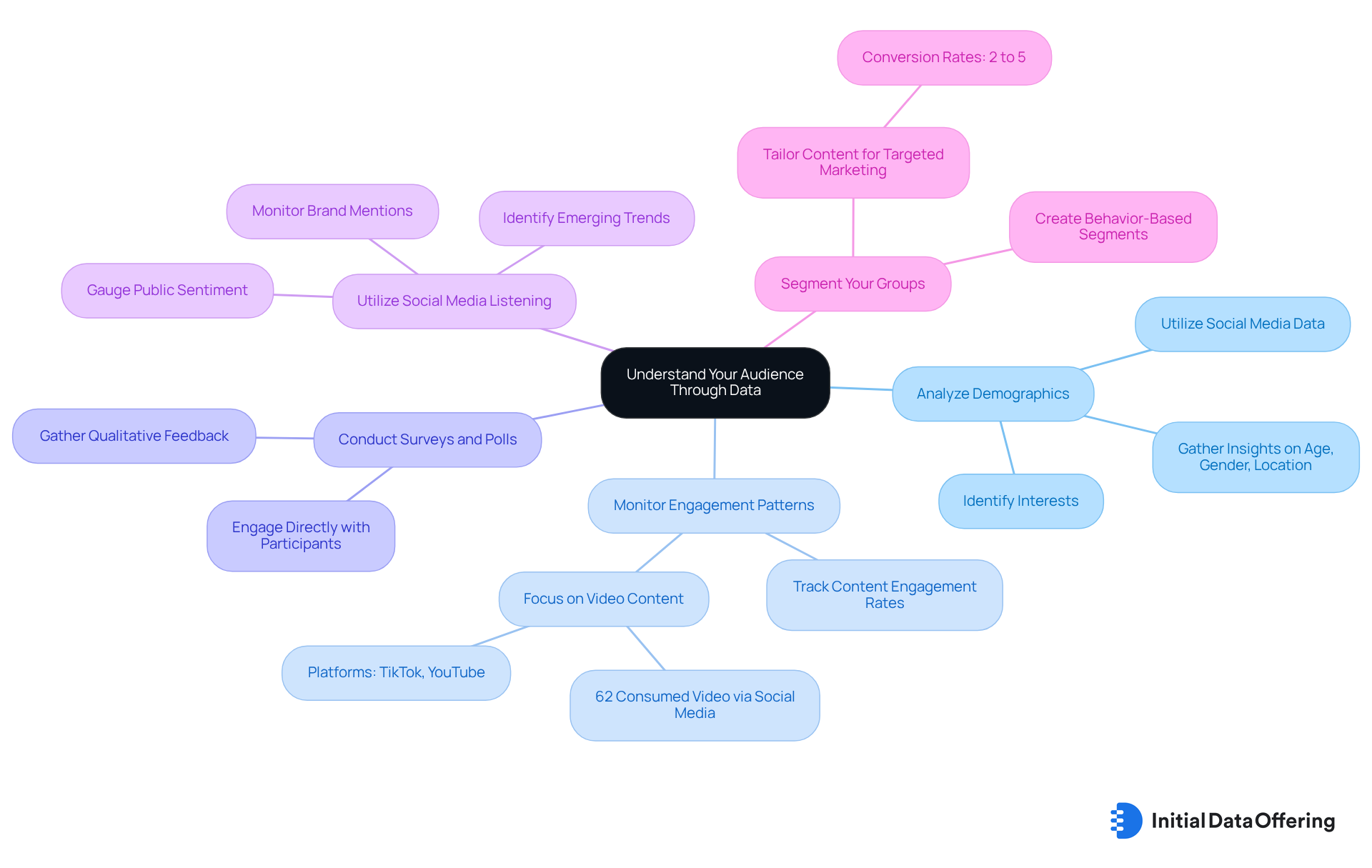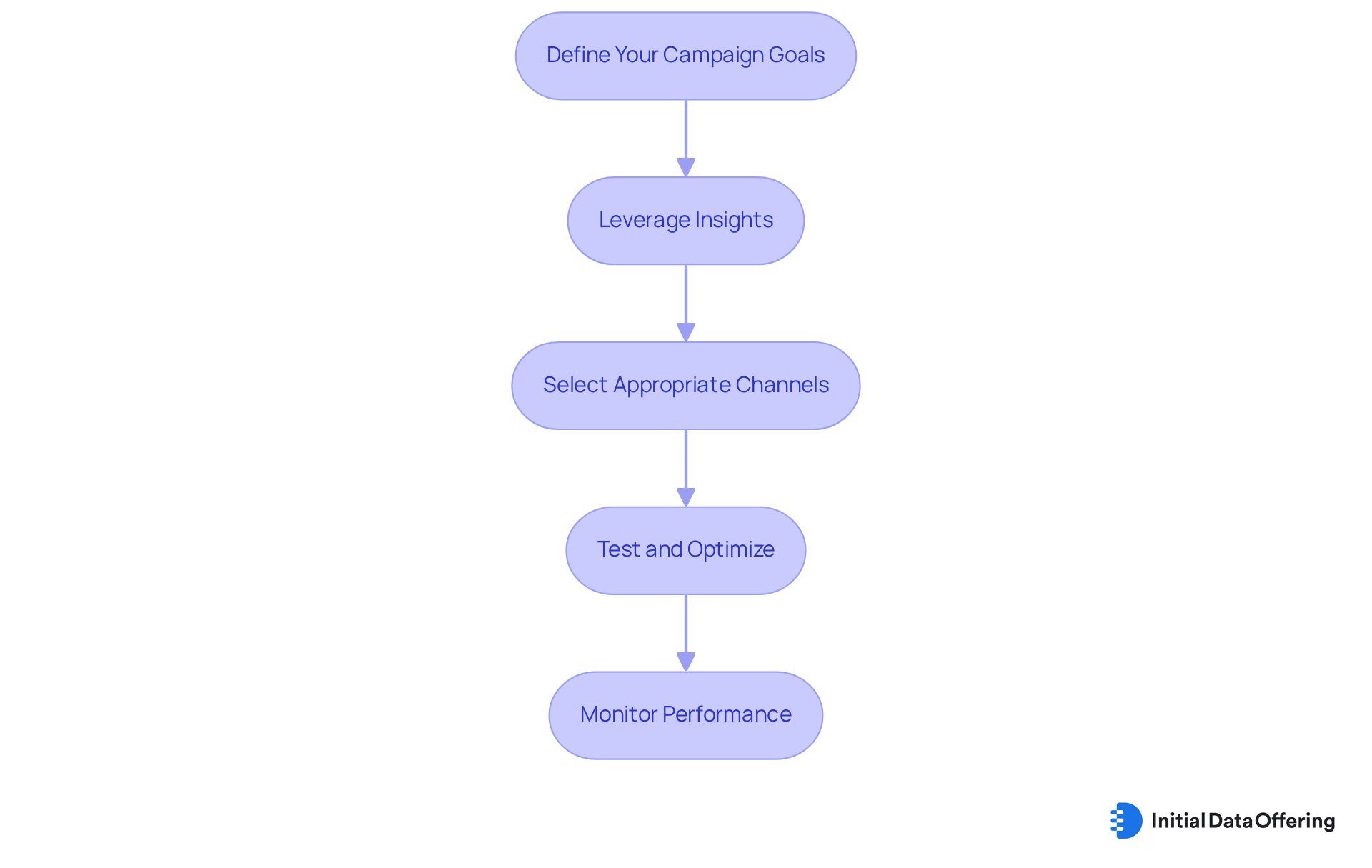5 Steps to Leverage Social Media Data for Market Insights

5 Steps to Leverage Social Media Data for Market Insights
Overview
The article outlines five key steps to effectively leverage social media data for gaining market insights. It emphasizes the importance of analytics in understanding consumer behavior and enhancing marketing strategies. By utilizing various types of analytics—descriptive, diagnostic, predictive, and prescriptive—businesses can make data-informed decisions. This alignment of marketing efforts with audience preferences and market trends ultimately drives growth and improves engagement.
How can your business harness these insights to stay ahead in a competitive landscape?
Introduction
Social media has fundamentally transformed how businesses comprehend their audiences, presenting a wealth of data that can significantly influence strategic marketing decisions. By leveraging social media analytics, organizations can uncover valuable insights into consumer behavior, engagement trends, and content effectiveness. This data not only highlights the features of audience interaction but also reveals advantages that can lead to more targeted marketing efforts. However, the challenge lies in effectively interpreting this data to create actionable strategies.
How can businesses navigate the complexities of social media analytics to enhance their marketing efforts and stay ahead of evolving consumer preferences?
Define Social Media Analytics
Network analytics encompasses the organized gathering, measurement, and examination of social media data from online platforms, providing insights into user behavior and engagement. This process includes monitoring key metrics such as likes, shares, comments, and overall reach. By exploring social media data, companies can assess the effectiveness of their content, recognize emerging trends, and make informed choices that enhance their media strategies.
In 2025, efficient online platform analysis is not only essential for evaluating past performance but also for predicting upcoming trends and consumer behaviors. This capability positions social media data analytics as a vital tool for marketers and businesses aiming to improve engagement and drive strategic growth. With 92% of marketers in larger companies anticipated to employ these tools by 2022, the significance of online analytics in shaping effective marketing strategies is profound.
How can your organization leverage these insights? Utilizing network analytics can empower your marketing efforts, enabling you to adapt proactively to changing consumer behaviors and preferences. The integration of these analytical tools will not only enhance your understanding of audience engagement but also position your business for sustained growth in an increasingly competitive landscape.

Explore Types of Social Media Analytics
Businesses can leverage various types of social media analytics to enhance their marketing strategies effectively.
-
Descriptive Analytics summarizes historical information to provide insights into past performance, focusing on metrics such as total engagement, reach, and impressions. For instance, a brand might analyze its social media posts to determine which content generated the most interactions over the last quarter. This analysis not only reveals what has worked but also helps in setting benchmarks for future campaigns by leveraging social media data.
-
Diagnostic Analytics explores the reasons behind specific outcomes by examining correlations and patterns within the information. For example, if a campaign saw a spike in engagement, diagnostic analytics can help identify which posts or strategies contributed to that increase. Understanding these dynamics through social media data allows businesses to refine their approaches and replicate successful tactics.
-
Predictive Analytics utilizes historical information to forecast future trends and consumer behaviors. This capability allows businesses to anticipate shifts in preferences, such as predicting which products might gain popularity based on past engagement metrics. As noted by RavenPack, predictive analytics can significantly enhance decision-making by providing insights into potential future outcomes, thereby enabling proactive strategies.
-
Prescriptive Analytics takes an additional step by suggesting actions based on insights. It guides businesses on optimal strategies to implement, such as suggesting the best times to post or which types of content to prioritize for maximum engagement. This actionable guidance empowers businesses to make informed decisions that can lead to improved performance.
By understanding and applying these analytics types, businesses can effectively align their marketing efforts with data-driven insights, ultimately enhancing their decision-making processes. However, it is essential to consider the fragmented nature of information sources, which can pose challenges in integrating and analyzing information effectively. Furthermore, present trends suggest an increasing dependence on sophisticated analytical tools to manage the intricacies of online information.

Interpret Social Media Data Effectively
To interpret social media data effectively, it is essential to follow these steps:
-
Set Clear Objectives: Begin by defining your goals. Are you aiming to enhance engagement, drive traffic, or increase conversions? Establishing clear objectives is crucial for guiding your analysis and ensuring that your efforts are aligned with your desired outcomes.
-
Choose Relevant Metrics: Select metrics that align with your objectives. For instance, if your goal is to boost brand awareness, focus on reach and impressions. Current metrics utilized by businesses in 2025 include engagement rates, conversion metrics, and sentiment analysis, which collectively offer a comprehensive view of social media data performance.
-
Analyze Trends Over Time: Examine your information for patterns over time rather than isolated points. This longitudinal analysis aids in evaluating the effectiveness of your strategies and adjusting to evolving viewer behaviors. Monitoring sentiment trends can also reveal emerging perceptions about your brand, offering valuable insights for future initiatives.
-
Segment Your Audience: Disaggregate your information by demographics, interests, or behaviors to uncover deeper insights into various audience segments. This segmentation allows for more targeted marketing strategies, enhancing engagement by catering to specific preferences and needs.
-
Use Visualization Tools: Leverage charts and graphs to illustrate trends, making it simpler to identify patterns and insights. Visualization not only aids in grasping intricate information but also enhances the communication of results to stakeholders, fostering a deeper understanding of the data.
By implementing these steps, businesses can convert raw online data, such as social media data, into actionable insights that guide strategic decisions and promote growth. For instance, the case study 'Automatically Tracking Platforms with Google Analytics' demonstrates how businesses can effectively assess traffic from various channels. Insights from industry experts further highlight the significance of comprehending user engagement. As one expert noted, "Done well, social media analytics provides a clearer view of your followers, your content performance, and your brand’s impact across channels.

Understand Your Audience Through Data
To effectively understand your audience through data, consider the following approaches:
-
Analyze demographics: Utilizing social media data and analytics tools to gather insights on age, gender, location, and interests of your audience is essential. This foundational social media data is crucial for creating targeted content that resonates with specific segments, ultimately enhancing engagement and satisfaction.
-
Monitor Engagement Patterns: Tracking which types of content yield the highest engagement rates is vital. In 2025, video content is projected to dominate, with platforms like TikTok and YouTube leading in user interaction. Understanding whether your followers respond better to videos, images, or text posts can inform your content strategy. For instance, a recent report indicates that video consumption is increasing, with 62% of respondents consuming video via social media in the previous week. This insight can guide your content creation efforts effectively.
-
Conduct Surveys and Polls: Engaging directly with your participants to gather feedback on their preferences and interests provides valuable qualitative data. This enhances quantitative analytics, offering a more comprehensive view of public sentiment and expectations. As market research analysts suggest, direct engagement can reveal insights that analytics alone may miss, allowing for more tailored marketing strategies.
-
Utilize social media data by implementing social listening tools to monitor conversations and mentions of your brand across social media. This practice helps gauge public sentiment and identify emerging trends through social media data, allowing for timely adjustments to your marketing strategies. For instance, brands that actively listen to their consumers can adapt their messaging to align with current interests and concerns, fostering stronger connections with their audience.
-
Segment Your Groups: Creating segments based on behavior and preferences enables more effective marketing efforts. This targeted approach allows for tailored content, significantly enhancing engagement and conversion rates. Studies indicate that targeted marketing can result in conversion rates between 2% and 5% in online campaigns, showcasing the effectiveness of this strategy.
By employing these strategies, businesses can cultivate a deeper understanding of their customers, leading to more impactful marketing campaigns. As market research analysts emphasize, monitoring engagement patterns is essential for adapting to the evolving landscape of social media, where user preferences are continually shifting.

Create Data-Informed Marketing Campaigns
To create data-informed marketing campaigns, follow these steps:
-
Define Your Campaign Goals: Clearly outline your objectives, such as increasing brand awareness or driving sales. Establishing specific, measurable goals is crucial for tracking success. As Vincent Scaglione notes, defining clear KPIs that align with business goals keeps efforts strategic and measurable, ensuring that every action taken is purposeful and directed toward desired outcomes.
-
Leverage Insights: Utilize social media data about your viewers to tailor your messaging and content, ensuring it resonates with your target demographic. Research indicates that 80% of buyers are more likely to purchase from brands that provide personalized experiences, highlighting the importance of relevant interactions. Moreover, 73% of consumers anticipate businesses to comprehend their distinct requirements, further emphasizing the necessity of utilizing consumer insights to foster stronger connections.
-
Select Appropriate Channels: Choose social media platforms that match the preferences and behaviors of your target group. For instance, if your viewers mainly interact on Instagram, focusing your efforts there can significantly enhance impact. This strategic alignment ensures that your social media data effectively reaches the right audience.
-
Test and Optimize: Implement A/B testing to compare different versions of your campaign. This method enables you to evaluate performance metrics and enhance based on what connects most effectively with your viewers. Recent trends show that marketers are increasingly adopting A/B testing to refine their strategies and enhance engagement, particularly in 2025, making it a vital tool for continuous improvement.
-
Monitor Performance: Continuously assess your campaign's effectiveness using social media data and analytics tools. Real-time data analysis enables you to adjust your strategy promptly, ensuring alignment with audience needs and preferences. This proactive approach allows businesses to stay ahead in a rapidly changing market landscape.
By following these steps, businesses can ensure their marketing campaigns are not only creative but also grounded in data-driven insights, leading to more effective outcomes. As highlighted in the case study "Driving Efficiency and Engagement Through Data-Driven Marketing," companies adopting data-driven strategies experience significant benefits, including an 80% increase in return on media spend over five years. Companies that embrace data-driven marketing will set the bar for personalization and strategic insight, ultimately driving better results.

Conclusion
Leveraging social media data is increasingly essential for businesses aiming to gain market insights and enhance their marketing strategies. By effectively analyzing various types of social media analytics, companies can not only understand past performance but also predict future trends. This capability allows them to make informed decisions that drive engagement and growth.
The article outlined several key components of social media analytics, including:
- Descriptive analytics
- Diagnostic analytics
- Predictive analytics
- Prescriptive analytics
Each type serves a unique purpose: descriptive analytics summarizes historical performance, while diagnostic analytics uncovers reasons behind past results. Predictive analytics forecasts future trends, and prescriptive analytics suggests optimal strategies for future campaigns. Furthermore, practical steps for interpreting social media data were discussed, emphasizing the importance of:
- Setting clear objectives
- Choosing relevant metrics
- Utilizing visualization tools to derive actionable insights
In a rapidly evolving digital landscape, businesses must prioritize data-informed marketing campaigns to remain competitive. By integrating social media analytics into their strategies, companies can foster deeper connections with their audience and respond proactively to changing preferences. Ultimately, this approach leads to better results. Embracing these insights will not only enhance marketing effectiveness but also pave the way for sustained growth in the future.
Frequently Asked Questions
What is social media analytics?
Social media analytics involves the organized gathering, measurement, and examination of data from social media platforms to gain insights into user behavior and engagement. It includes monitoring key metrics such as likes, shares, comments, and overall reach to assess content effectiveness and recognize trends.
Why is social media analytics important for businesses?
Social media analytics is crucial for businesses as it helps evaluate past performance and predict future trends and consumer behaviors. This capability allows marketers to improve engagement and drive strategic growth, making it a vital tool for effective marketing strategies.
What types of social media analytics are available?
There are four main types of social media analytics: 1. Descriptive Analytics - summarizes historical information to provide insights into past performance. 2. Diagnostic Analytics - explores reasons behind specific outcomes by examining correlations and patterns. 3. Predictive Analytics - utilizes historical data to forecast future trends and consumer behaviors. 4. Prescriptive Analytics - suggests actions based on insights to guide businesses on optimal strategies.
How can descriptive analytics be used?
Descriptive analytics can be used to summarize historical data, focusing on metrics like total engagement, reach, and impressions. For example, a brand can analyze past social media posts to determine which content generated the most interactions, helping to set benchmarks for future campaigns.
What is the role of diagnostic analytics?
Diagnostic analytics helps businesses understand the reasons behind specific outcomes by examining patterns within the data. For instance, it can identify which posts contributed to a spike in engagement, allowing businesses to refine their strategies and replicate successful tactics.
How does predictive analytics benefit businesses?
Predictive analytics benefits businesses by using historical data to forecast future trends and consumer behaviors. This allows companies to anticipate shifts in preferences and make proactive decisions, enhancing their strategic planning.
What does prescriptive analytics provide?
Prescriptive analytics provides actionable guidance by suggesting optimal strategies for businesses, such as the best times to post or which types of content to prioritize for maximum engagement.
What challenges do businesses face in social media analytics?
Businesses may face challenges due to the fragmented nature of information sources, making it difficult to integrate and analyze data effectively. There is also an increasing dependence on sophisticated analytical tools to manage the complexities of online information.